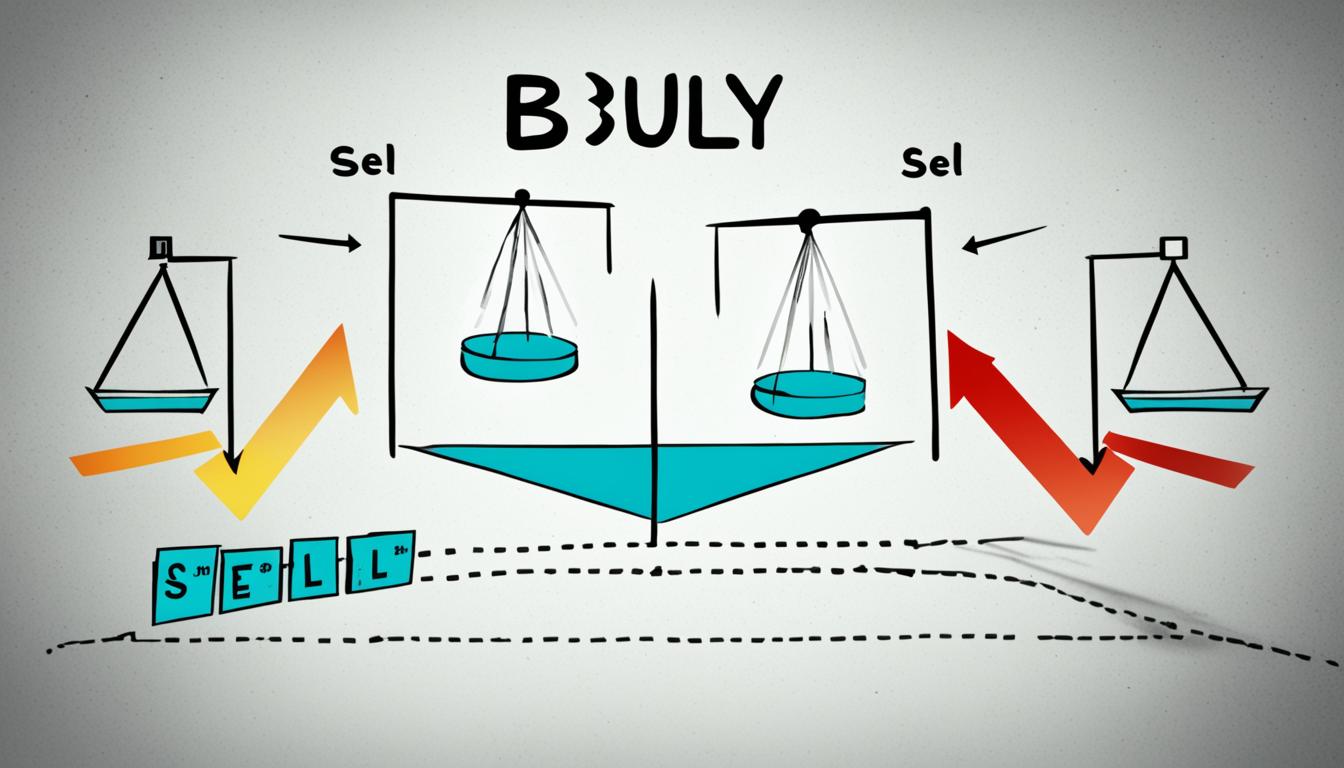In the dynamic world of finance, the arbitrage strategy is a big draw for smart investors. This method is about making a risk-free profit by using price differences in various markets. By finding and using these price gaps, investors can get good returns without much risk.
To get into financial markets, knowing arbitrage basics is vital. Whether it’s stocks or complex derivatives, opportunities are everywhere for those ready to jump in. This article will guide you through arbitrage, offering tips to boost your returns.
Key Takeaways
- Arbitrage involves exploiting price differences in different markets.
- It offers a method to secure risk-free profits.
- Understanding market inefficiencies is key to successful arbitrage.
- Tools like quantitative analysis and trading algorithms are essential.
- It’s important to be aware of the risks and challenges in arbitrage.
Introduction to Arbitrage Investment Strategy
Arbitrage stands out as a key player in the financial world. It lets investors use price differences across markets to earn risk-free money. It also helps the market work better.
What is Arbitrage?
Arbitrage is about spotting price gaps between markets or items. Investors buy low in one place and sell high in another. This ensures they make a sure profit. It makes sure prices on different platforms stay consistent.
History and Evolution of Arbitrage
Arbitrage has come a long way since trading began. It started with simple goods swaps. Now, it uses high-tech methods and algorithms. Modern arbitrage covers things like stocks and derivatives, adding value to finance.
Importance in Financial Markets
Arbitrage is vital for a few reasons. First, it keeps market prices in check. Second, it adds liquidity, aiding trades. Lastly, it supports more complex trades with tools like derivatives, making markets stable.
| Feature | Stock Trading | Derivative Instruments |
|---|---|---|
| Primary Function | Buying and selling stocks | Managing risk through contracts |
| Role in Arbitrage | Exploiting price differences in stock prices | Hedging and speculative opportunities |
| Market Impact | Enhances liquidity and price discovery | Provides leverage and risk management |
Types of Arbitrage Opportunities
Arbitrage opportunities in the financial markets come in many shapes and forms. These opportunities let investors take advantage of market inefficiencies. We’ll explore the different types of arbitrage. Each one serves a specific purpose and requires a unique approach.
Pure Arbitrage
Pure arbitrage lets investors make risk-free profits by taking advantage of price differences. For example, buying a stock where it’s cheap and selling it where it’s expensive can bring in good money. This method focuses on quick action and accurate information.
Risk Arbitrage
Risk arbitrage is linked to mergers and acquisitions. It involves buying stock in a company being acquired and sometimes selling the acquirer’s stock short. The profits come from predicting how stock prices will change after a deal is announced. However, it’s risky because deals can fall through or face legal issues.
Statistical Arbitrage
Statistical arbitrage uses math and algorithms to find trading chances. By studying past price trends, investors can guess where prices will go next. This complex method uses fast trading and pairs stocks to manage risk. The success of statistical arbitrage relies on using sturdy models and accurate information.
Identifying Market Inefficiencies
Finding market inefficiencies is key for making money in arbitrage. These inefficiencies offer moments for investors to make profitable trades. By looking closely at numbers, investors find small price differences across markets.
Advanced number analysis uses stats and math to look deeply into market data. This helps spot patterns and odd things that normal methods don’t catch. Techniques like statistical arbitrage, event studies, and cross-market analysis are used for finding inefficiencies.
- Statistical Arbitrage: Uses past price data to guess future prices.
- Event Studies: Looks at how big events affect stock prices.
- Cross-market Analysis: Compares prices of similar assets in different markets.
Using multiple methods together is the best way to find good trading chances. The mix of these methods makes it more likely to spot wins:
| Techniques | Description | Advantages |
|---|---|---|
| Statistical Arbitrage | Uses old data to see price patterns. | Reliable because it’s based on past data. |
| Event Studies | Looks at price changes after big events. | Gives clues based on those events. |
| Cross-market Analysis | Checks asset prices in different markets. | Finds price differences for arbitrage. |
In short, using deep number analysis to find market inefficiencies can really improve arbitrage investments. Mixing different methods helps uncover chances that might be missed. This creates a strong base for making money.
Tools and Techniques for Effective Arbitrage
Arbitrageurs use advanced tools and techniques to stay ahead in the market. These resources help them find and act on profitable moves quickly. We’ll look into quantitative analysis, trading algorithms, and market monitoring software in detail.
Quantitative Analysis
Quantitative analysis stands at the core of arbitrage. It uses statistics and math to spot market differences. Hedge funds often have teams of experts to dig through data and find valuable trades.
Trading Algorithms
Trading algorithms make trading much faster. They act on arbitrage chances in seconds, working with huge data volumes. This speed helps traders use short-lived market chances. Many big investors use these systems to keep their trading strong.
Market Monitoring Software
Market monitoring software is crucial for arbitrage traders today. It gives live data and insights to keep an eye on markets. This lets investors combine data analysis with up-to-the-minute market info. Making smart moves fast boosts their profits.
To sum up, using quantitative analysis, trading algorithms, and market monitoring software is key for hedge funds and big investors. These tools make trading more accurate and quick. They help investors stay on top of market shifts.
Risks and Challenges in Arbitrage Investment Strategy
Arbitrage investment strategies seem like they promise risk-free profit. But they come with their challenges. Investors need to know these obstacles to succeed in the financial markets.
Market Risk
Market risk involves liquidity and volatility. Financial market fluctuations can lower profits or increase losses. It’s crucial for arbitrageurs to effectively manage these risks.
Execution Risk
Execution risk comes from timing and slippage issues. Rapid price changes of assets can harm entry or exit points. Good timing is key to beating these challenges.
Regulatory Risk
Regulatory changes pose a big risk too. Laws and rules change often, affecting arbitrage. Investors must adapt quickly while following the rules.
Case Studies of Successful Arbitrage Strategies
The real-world use of arbitrage strategies is both interesting and effective. We’ll look at important examples from history and today. These examples show how trading stocks and using derivative tools work. They help us learn for future investments.
Historical Examples
The 1987 Black Monday crash offers a famous example of arbitrage. Smart investors found price differences between stocks and their future indexes. They used these differences to lessen losses and even make big profits. This shows how derivatives are key in arbitrage during unstable markets.
Modern Implementation
Today, new technology has changed arbitrage. Hedge funds and big investors use advanced algorithms to find market gaps quickly. Renaissance Technologies stands out in this area.
They use statistical arbitrage for amazing returns. Their strategy uses complex math and fast trades. It highlights the power of tech and math in trading today.
Lessons Learned
Several lessons come from these examples. First, being fast is crucial in arbitrage. High-speed trading algorithms are vital. Second, you must always watch the market to spot and use price gaps quickly. Lastly, arbitrage can be profitable but has its risks. Good risk management is necessary.
FAQ
What is an arbitrage investment strategy?
The strategy is about buying and selling an asset at the same time in different places. This is to make a profit from the price differences. It uses market flaws to create gains.
How does arbitrage ensure risk-free profits?
It uses price differences between markets for profit. By buying low in one market and selling high in another, it locks in profits. This is done without market risk.
What types of arbitrage opportunities are available?
There are three main types. Pure arbitrage is without risk. Risk arbitrage bets on profits from mergers. Statistical arbitrage uses math to find trades.
How can investors exploit price differences in financial markets?
They use deep analysis and algorithms to find these differences. These methods detect and act on opportunities fast and effectively.
What role does quantitative analysis play in arbitrage?
Quantitative analysis uses math to find market gaps. It analyzes big data to find arbitrage chances that are not easy to see.
What risks are associated with arbitrage investment strategy?
The risks include market changes, timing issues, and law changes. These can affect prices and arbitrage plans.
What tools do arbitrageurs use to maximize returns?
They use advanced analysis, algorithms, and software. These tools are crucial for hedge funds and big investors to stay on top and make more money.
Can you provide examples of successful arbitrage strategies?
Many have made big profits from arbitrage during big market events or within certain rules. Case studies show how these profits were made and the strategies behind them.
Why is arbitrage important in financial markets?
It keeps markets efficient and liquid by using price gaps. Arbitrageurs help match prices in different markets. This makes financial systems more stable.
What are some challenges faced by arbitrage strategies?
Challenges include risks from market changes, timing delays, and new laws. These can make arbitrage harder to do successfully.






